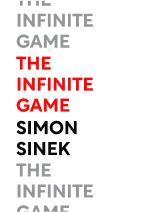

This article is an excerpt from the Shortform book guide to "The Infinite Game" by Simon Sinek. Shortform has the world's best summaries and analyses of books you should be reading.
Like this article? Sign up for a free trial here .
What does it mean to lead with an infinite mindset? What attitude differentiates an infinite-minded leader?
A finite-minded leader plays to defeat others. In contrast, a leader who adopts the infinite mindset plays to maintain a healthy position within a competitive field.
Sinek outlined five guidelines for leading with an infinite mindset.
Developing an Infinite Mindset
A leader who sees their business as part of an infinite game will make decisions based on long-term strategies that develop long-term strength, while someone who plays a finite game will aim for short-term wins that might weaken their organization in the long run. Consistently, businesses that succeed over many years are run by leaders with infinite mindsets, while businesses that fail are run by leaders with finite mindsets.
Sinek discusses several key differences in the attitudes and beliefs of finite and infinite mindsets:
- “It’s about me” versus “It’s about us”: A finite-minded leader thinks only of herself and her own company, while an infinite-minded leader considers the impact her company will have on her employees, her community, the economy, and the outside world.
- Reactive versus proactive: Finite-minded players react to disruptions, while infinite-minded players anticipate them and proactively prepare for them.
- Short-term versus long-term goals: Finite-minded work to benefit their near-term bottom line, while infinite-minded players work toward a longer-term view of success. Ironically, infinite-minded companies often end up with higher profits even though they’re not focused as fixedly on their bottom line because their longer-term strategies pay off over time.
- Short-term threats versus long-term threats: Finite-minded leaders center their corporate strategies around responding to specific, definable threats posed by their rivals. Infinite-minded leaders focus on exploring opportunities or developing innovations that might strengthen their organizations.
- Stability versus resilience: Finite-minded companies try to weather storms. Infinite-minded companies aim not just to weather storms but to be made stronger by them. They are resilient rather than merely stable.
Case Study: Microsoft and Apple
To illustrate his point about the advantages of infinite mindset, Simon Sinek discusses the difference between how Microsoft and Apple view the world. He quotes this Microsoft versus Apple example often and it has become widely associated with his theories.
Sinek relates how he attended the corporate conferences of both Microsoft and Apple. At the Microsoft conference, the majority of the speakers talked about how they could beat Apple, their primary competitor. By contrast, at Apple’s conference, all the speakers talked about how they could continually improve their customers’ experiences through innovation.
Because of its focus on Apple instead of on its own vision, Microsoft based its decisions reactively on Apple’s decisions, and it was always a step behind Apple. When Apple released the iPod, Microsoft responded with the Zune, which wasn’t able to capture the public’s attention, and later, when Apple released the iPhone, then-CEO Steve Ballmer (who replaced the more infinite-minded Bill Gates in 2000) dismissed it as not worth the effort to replicate, deciding that the cell phone market was already spoken for. His laser focus on market share and immediate sales potential blinded him to the seismic shift that was about to happen to the cell phone market.
Sinek notes that the original strategy and vision of Microsoft, under Gates, had an infinite focus: “To empower every person and every organization to achieve more.” He suggests that this was largely responsible for the company’s success, and had Ballmer adhered to this vision when he took over as CEO, he might have been more effectively forward-thinking, rather than reactionary.
How to Lead With an Infinite Mindset
Sinek outlines these five guidelines to help you develop an infinite mindset and build a strong, resilient company:
- Advance a just cause.
- Build trusting teams.
- Study your worthy rivals.
- Be ready to pivot on a fundamental level.
- Demonstrate the courage to lead.
Sinek notes it’s important to adopt all five of these guidelines in order to achieve the full potential of the fully infinite mind.
1) Advance a Just Cause
According to Simon Sinek, an infinite mindset begins with a Just Cause. A Just Cause is a big-picture vision that provides a framework for your corporate strategies. It provides a context for all the decisions you’ll make. It inspires people to work hard and make sacrifices because they believe in the cause. A Just Cause has five elements:
- It stands for something, not against something: It’s optimistic and hopeful.
- It’s idealistic: It’s inspiring, bold, and ultimately unachievable.
- It’s inclusive: It invites and inspires others to join.
- It’s resilient: It can endure technological, cultural, political, and industry changes.
- It’s service-oriented: It’s aimed at the benefit of others.
| Southwest’s Just Cause Led Its Success Prior to the publication of The Infinite Game, in a speech Sinek named Southwest Airlines as an example of a company with a Just Cause, because its mission went beyond just being an airline—it aimed to allow average people to afford to fly instead of driving or taking a bus somewhere. Other management thinkers have also discussed how Southwest’s core purpose allowed it to succeed in oftentimes challenging circumstances, through industry upheavals and economic downturns. Greg McKeown explains in his book Essentialism, that to stay true to its cause, Southwest made trade-offs so as not to get distracted by alternative ways it could serve its customers. Instead, Southwest stayed focused on what made it unique. For example, the company decided not to offer meals or upgraded seating, and to serve only a limited selection of airports. In this way it stayed true to its Just Cause and was able to make effective business decisions. |
2) Build Trusting Teams
Sinek’s second guideline for developing an infinite mindset is to build trusting teams. A trusting team is a team made up of people who feel safe around each other—safe expressing their feelings, asking for help, talking about problems, and admitting to mistakes.
| The Importance of Trust The Center for Creative Leadership (CCL) published a report in 2017, prior to Sinek’s book, that advances many of the same philosophies on trusting teams. They define trust as “the bridge between the business need for results and the human need for connection.” Like Sinek, the report notes that trust is a key element in a properly functioning organization—when workers trust each other they unite towards a common goal, take risks with their thinking, and communicate openly. In the absence of trust, workers compete, hoard information, and don’t advance new ideas. Without trust, a corporate culture defaults to the lowest common denominator of behavior and is unable to achieve anything truly meaningful. The CCL notes that when they first published research on trust in 1999, it was considered a “soft” subject and not taken seriously. However, more recently, people have grown aware of the importance of trust and of the fact that teams without it don’t perform well. They recommend that leaders turn to trust-building programs if they sense certain problems in their team, such as a lack of enthusiasm, a reluctance to speak up, intra-team competition, or an attachment to the status quo. Each of these things may indicate a feeling of insecurity or a lack of connection between team members. |
3) Study Your Worthy Rivals
Sinek’s third method of developing your infinite-minded leadership is to study your worthy rivals. A worthy rival is a competitor who is better than you at certain things, and who can therefore reveal to you ways you can improve, enabling you to better survive in the infinite game. A worthy rival may make a better product, provide a better service, or command stronger customer loyalty than you do: anything from which you can draw lessons.
| Worthy Rivals Turn Competition into Cooperation Timothy Gallwey also discusses how competition can improve performance in his book The Inner Game of Tennis. He contends that to achieve whatever goal you’re aiming for, you must overcome small obstacles along the way, and because a competitor presents you with these obstacles, they are a necessary element in achieving that higher goal. The benefits of competition are mutual between both players. Each player benefits from the other’s attempts to block them with obstacles, and consequently, competition ends up functioning as cooperation, allowing both parties to improve. The rivalry between tennis players Roger Federer and Rafael Nadal exemplify both Sinek’s concept of Worthy Rivals and Gallwey’s theory of competition as cooperation. Both Federer and Nadal have achieved great success in part because their mutual respect for each other has helped them each become better athletes. Over the years, each player has publicly acknowledged the other’s strengths and the friendship they share. In 2020, when Nadal won his 20th Grand Slam title and tied Federer’s record, Federer responded by congratulating Nadal and calling him his “greatest rival over many years,” noting that their rivalry has “pushed each other to become better players.” |
4) Be Ready to Pivot on a Fundamental Level
Sinek’s fourth guideline that prepares you to lead with an infinite mindset is being prepared to pivot on a fundamental, existential level. An existential pivot is a purposeful, dramatic change that a person willingly makes in order to stay true to her Just Cause. It’s a move that pushes her out of her comfort zone and carries a risk of failure but is necessary in order for her to continue to play an infinite game.
| Nintendo’s Proactive Pivot Nintendo is an example of a company that was doing well in its established business but saw that by pivoting to a different business, it could be more successful over a longer period. The company was founded in 1889 as a playing card company and was one of Japan’s leading companies throughout the first half of the twentieth century. However, in the 1950s, then-president Hiroshi Yamauchi realized that playing cards had limited potential in the long run, and in the 1960s, the company pivoted to making toys. In 1970, it pioneered a few electronic toys (which became blockbuster sellers) and in the late 1970s started developing and distributing video games, which Yamauchi recognized as a market with enormous potential. The pivot paid off, and Nintendo has since sold some of the most iconic products in the industry, including Donkey Kong, Pokémon, and Game Boy. |
5) Demonstrate the Courage to Lead
Sinek’s fifth and final guideline to follow in developing your infinite mindset is to lead courageously. Leading courageously means working toward a better future, even if doing so puts your own career in jeopardy.
Sinek notes that when you lead courageously, you might take risks that investors warn against—not just any risks (as finite-minded leaders take risks, too), but specifically, risks that help you follow your Just Cause.
| In 2019, five years after CVS stopped selling cigarettes, CEO Larry Merlo reflected on how the decision had impacted their business and their strategy. He remarked that the company’s clear and consistent message on improving health gave them a competitive advantage over rival firms, and it paved the way for CVS’s acquisition of health insurer Aetna in 2018. That acquisition will allow them to continue to work toward their ultimate goal of helping people get healthy. Merlo noted that the company’s actions “show that the private sector can have a real impact in addressing the country’s greatest social challenges, without having to sacrifice the pursuit of success.” On an additional note, CVS’s acquisition of Aetna was, in and of itself, demonstrative of the company’s infinite mindset as it was a fundamental pivot that set them on a new path. It evolved from being simply a retail pharmacy to being a central part of its customers’ health. Its Just Cause allowed it to make strong, consistent business decisions even as it changed its practical operations. |

———End of Preview———
Like what you just read? Read the rest of the world's best book summary and analysis of Simon Sinek's "The Infinite Game" at Shortform .
Here's what you'll find in our full The Infinite Game summary :
- Why businesses who see the game as finite don't survive
- How to develop an infinite mindset that will put you and your organization on a path for long-term success
- How the purpose of business is changing






